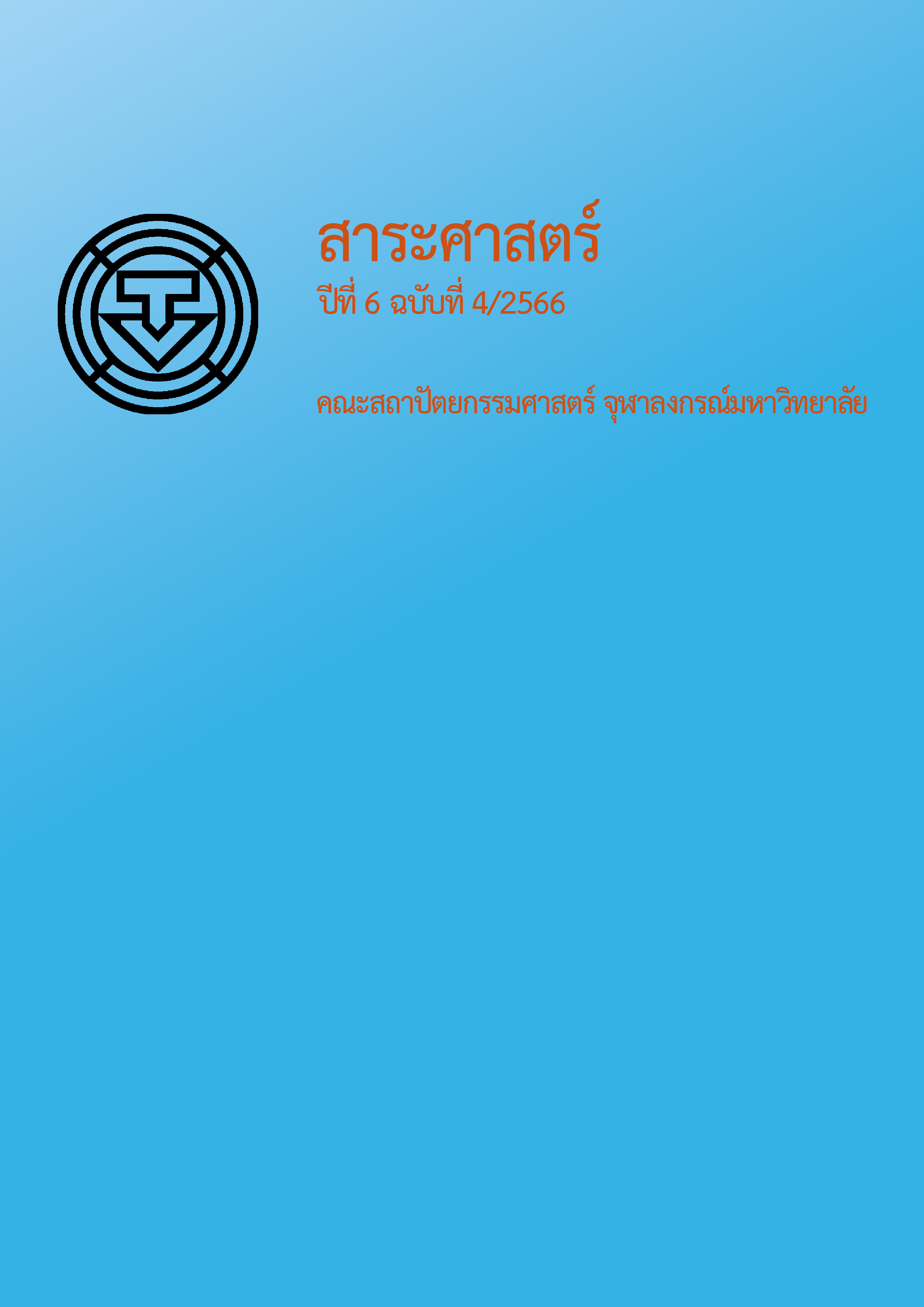The Role of Public Space and Semi-Public Space for Management Stress of Urban Residents: Case Study of Benchasiri Park and Quartier Water Garden, EmQuartier Shopping Center
Main Article Content
Abstract
The continuous changes in social and economic conditions have caused urban populations to face pressures from various factors, such as increasing living expenses, heavier workloads, crowded urban environments, and traffic problems, resulting in accumulated stress. Green spaces and public areas have become central areas for urban residents to use as a place to relax and engage in activities, thereby allowing public areas to play a role in managing the stress of urban populations in another dimension. The objectives of this study were: 1) to study behavior to compare the behavior of urban residents towards the use of public and semi-public areas, 2) to compare the satisfaction of urban residents towards factors affecting the choice of public and semi-public areas for stress management, and 3) to propose guidelines for the development of public areas that are appropriate to the behavior of urban residents in managing stress. The tools used to collect data were questionnaires distributed to a sample of 400 people and statistics for data analysis, including frequency, percentage, mean, standard deviation, chi-square, and t-tests. A comparison between Benchasiri Park and the EmQuartier shopping center in the area of the Quartier Water Garden found that the Quartier Water Garden offered better amenities than Benchasiri Park. However, Benchasiri Park offered a greater variety of activities. And both public areas play a role in making visitors feel the relaxation sensation. Therefore, to maximize the benefits of public spaces in managing the stress of urban residents, the first step should be to create cooperation between the government, private sector, and the public to find ways to develop public spaces that truly meet the needs of all sectors. Next is to develop the areas that are lacking in each location, such as improving facilities and promoting activities for all ages and genders, designing interesting spaces to create a comfortable atmosphere that will encourage people to spend more time there. The second step is to promote the development of small public gardens or parks in the city by motivating the private sector to use their land for public benefit, creating a good urban environment that is friendly to the city's population and the environment to create a good quality of life that is far from stress.
Article Details
References
กฤติยา อุนะพำนัก. (2559). เรื่องภูมิทัศน์บริการที่มีผลถึงความภักดีของผู้บริโภคต่อศูนย์การค้าในเขตกรุงเทพมหานคร[วิทยานิพนธ์ปริญญามหาบัณฑิต ไม่ได้ตีพิมพ์]. มหาวิทยาลัยธรรมศาสตร์.
กาวเนตร สะใบ. (2552). แนวทางการออกแบบเพื่อการใช้ประโยชน์พื้นที่ว่างสาธารณะและกึ่งสาธารณะตามแนวถนน : กรณีศึกษาย่านอโศก-นานา ถนนสุขุมวิท [วิทยานิพนธ์ปริญญามหาบัณฑิต ไม่ได้ตีพิมพ์]. จุฬาลงกรณ์มหาวิทยาลัย.
จันทร์ ผ่องศรี. (2527). นันทนาการ. ภาควิชาพลศึกษา คณะครุศาสตร์ จุฬาลงกรณ์มหาวิทยาลัย.
ธนกร จุดาศรี. (2558). แนวทางการออกแบบพื้นที่สาธารณะที่ตอบรับกับพฤติกรรมของคนรุ่นใหม่ [วิทยานิพนธ์ปริญญามหาบัณฑิต ไม่ได้ตีพิมพ์]. มหาวิทยาลัยศิลปากร.
นาตยา สุวรรณจันทร์. (2560). การศึกษาความเครียดในการปฏิบัติงานของผู้บริหารสถานศึกษาสังกัดสำนักงานเขตพื้นที่การศึกษา เขต 11 [วิทยานิพนธ์ปริญญามหาบัณฑิต ไม่ได้ตีพิมพ์]. มหาวิทยาลัยราชภัฏสุราษฎร์ธานี.
เปรม วาทบัณฑิต. (2552). การจัดการความเครียดของนักกีฬามหาวิทยาลัยเชียงใหม่ในการแข่งขันกีฬามหาวิทยาลัยแห่งประเทศไทย [วิทยานิพนธ์ปริญญามหาบัณฑิต ไม่ได้ตีพิมพ์]. มหาวิทยาลัยเชียงใหม่.
แพรพลอย วัฒนะโชติ. (2564). การวิเคราะห์เครือข่ายนโยบายในการพัฒนาพื้นที่สาธารณะสีเขียวในเขตกรุงเทพมหานคร [วิทยานิพนธ์ปริญญามหาบัณฑิต ไม่ได้ตีพิมพ์]. มหาวิทยาลัยศรีนครินทรวิโรฒ.
มัญชุตา กัญชนะ. (2554). รูปแบบและแนวทางการบริหารจัดการเชิงนโยบายพื้นที่กึ่งสาธารณะของโครงการเอกชน : ย่านธุรกิจศูนย์กลางเมืองกรุงเทพมหานคร [วิทยานิพนธ์ปริญญามหาบัณฑิต ไม่ได้ตีพิมพ์]. จุฬาลงกรณ์มหาวิทยาลัย.
สุธาริน คุณผล (2541). บทสำรวจพื้นที่สาธารณะ. รัฐศาสตร์สาร, 20(3), 167-214.
Carr, Stephen & Stone, Andrew M. (1992). Public space. Cambridge University Press.
Elsamahy, Eslam M., & EL-Fattah, Rana Abd. (2018, October). Designing non stressed psychological public space. BAU Journal, special edition, 121-132.
Hackett, Brian. (1971). Landscape planning: An introduction to theory and practice. Oriel.
Marcus, Clare Cooper, & Francis, Carolyn. (1998). People places: Design guidelines for urban open space.Van Nostrand Reinhold.
Matthew, Carmona, & Steve, Tiesdell. (2007). Urban design reader. Elsevier.
Selye, H. (1976). The stress of life (Rev. ed). McGraw Hill Book.


